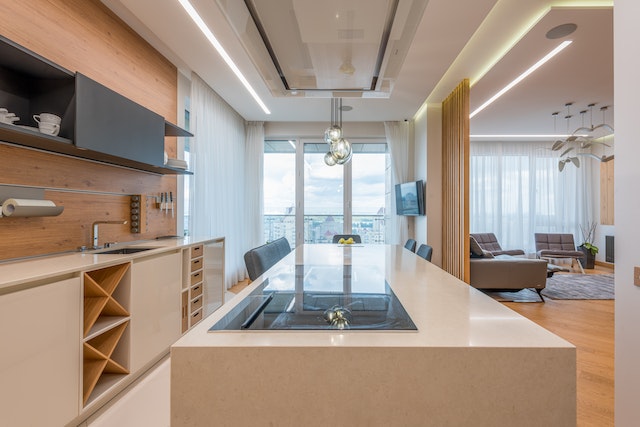
In the modern world, where space is at a premium, the art of creating functional boundaries has become paramount. As we seek to optimize every inch of our living spaces, room dividers have emerged as invaluable tools in transforming cramped interiors into well-defined, organized havens. With their versatility and aesthetic appeal, room dividers for small interiors offer a breath of fresh air, providing a sense of spaciousness while simultaneously adding character to any living area.
Types of Room Dividers
When it comes to room dividers for small interiors, the options are as vast as the imagination itself. From traditional to avant-garde, room dividers come in an array of styles, materials, and designs. Let’s delve into some of the most popular types, each offering their unique flair and practicality.
Folding Screens
Folding screens have long been a favorite among interior designers and homeowners alike. Not only do they effortlessly divide a room, but they also serve as decorative elements. Delicate hand-painted screens add an artistic touch, while bamboo or rattan screens evoke a natural and tropical ambiance.
Practical tip: Opt for screens with adjustable panels, allowing you to expand or contract the divider as needed.
Bookcase Dividers
For avid readers and collectors, bookcase dividers are a match made in heaven. These functional pieces not only divide a room but also act as a storage solution. Display your cherished novels, travel trinkets, or artful curios on the bookshelves.
Practical tip: Use different sized shelves to create visual interest and showcase your favorite pieces.
Sliding Panels
For those seeking a sleek and minimalist look, sliding panels offer a contemporary solution. Made of glass, wood, or even aluminum, these panels effortlessly glide along a track, allowing you to open or close off sections of a room.
Practical tip: Consider frosted or textured glass panels for added privacy while still allowing light to filter through.
Hanging Screens
Perfect for adding an artistic touch to your space, hanging screens bring a touch of whimsy and elegance. Made from various materials such as fabric, beads, or metal, these dividers are suspended from the ceiling, creating a visual and auditory boundary.
Practical tip: Experiment with different materials and colors to match your interior’s theme or create a focal point.
Curtain Dividers
If versatility and affordability are what you seek, curtain dividers are a fantastic option. From light and airy sheers to heavyweight velvet drapes, curtains can instantly transform a space. Opt for floor-to-ceiling curtains for a dramatic effect or select ones with whimsical prints to infuse personality into your room.
Practical tip: Install a ceiling-mounted track for seamless movement and to achieve a more polished look.
Privacy and Visual Separation

In today’s open-concept living spaces, creating privacy and visual separation can be a challenge. However, room dividers for small interiors offer an elegant solution, allowing you to maintain an open feel while still providing the necessary privacy. Let’s explore different ways to achieve privacy and visual separation using room dividers:
Lattice Screens: Lattice screens are a charming option for adding both privacy and architectural interest to your space. Whether made of wood, metal, or even plastic, these dividers allow light and air to pass through while obscuring the view.
Practical tip: Paint the lattice screens in a color that complements your interior to elevate their visual appeal.
Hanging Plants: For nature enthusiasts, incorporating hanging plants as room dividers for small interiors can provide a natural boundary while adding a touch of greenery. Whether you opt for trailing vines or cascading ferns, hanging plants not only separate different areas but also bring life and freshness to your interior.
Practical tip: Choose plants that thrive in the light conditions of your space and practice regular maintenance to keep them looking lush and vibrant.
Slatted Partitions: Slatted partitions offer a modern and contemporary approach to privacy and visual separation. Whether made of wood, metal, or even acrylic, these dividers consist of thin, horizontal slats arranged side by side. The slats allow light and air to filter through while creating a sense of seclusion.
Practical tip: Play with different widths of slats to achieve the desired level of privacy and adjust the spacing to create visual interest.
Textured Glass: If you desire privacy without sacrificing natural light, textured glass dividers are an excellent choice. Frosted, etched, or stained glass can add visual intrigue while diffusing the view, creating a sense of privacy while still allowing light to permeate the space.
Practical tip: Consider incorporating patterns or designs to further enhance the aesthetic appeal of the glass dividers.
Room Divider Shelves: Combining functionality with privacy, room divider shelves offer a practical and visually appealing solution. These units not only divide a room but also provide storage space for books, decor items, or even everyday essentials.
Practical tip: Arrange your belongings in an organized and visually pleasing manner, using the shelves to showcase your personal style.
Flexibility and Versatility
One of the true wonders of room dividers lies in their flexibility and versatility. These functional boundaries can be easily adjusted and reconfigured to suit our ever-changing needs and moods.
Modular Panels: If you value adaptability, modular panels are a fantastic option. These innovative dividers consist of individual panels that can be interchanged and rearranged to create countless configurations. By simply redesigning the arrangement, you can transform your living area from an open space for entertaining to a cozy retreat for relaxation.
Practical tip: Look for modular panels with multi-functional features, such as built-in storage shelves or display niches.
Mobile Screens: For those who relish in the freedom of movement and the ability to easily change up their space, mobile screens are the way to go. These lightweight dividers come equipped with wheels, allowing you to effortlessly roll them from one area to another. This means you can adapt your space for different activities, whether it’s creating a private workspace during the day and opening up the room for gatherings in the evening.
Practical tip: Opt for screens with lockable wheels to ensure stability when in use.
Open Bookcase Dividers: To add a touch of intrigue and multifunctionality to your interior, consider open bookcase dividers. These dividers not only visually separate different areas but also provide open storage opportunities. You can display your favorite books, decorative items, or even use the shelves to house plants for a fresh and vibrant atmosphere.
Practical tip: Experiment with unique arrangements and combinations of books and decor to showcase your personal style.
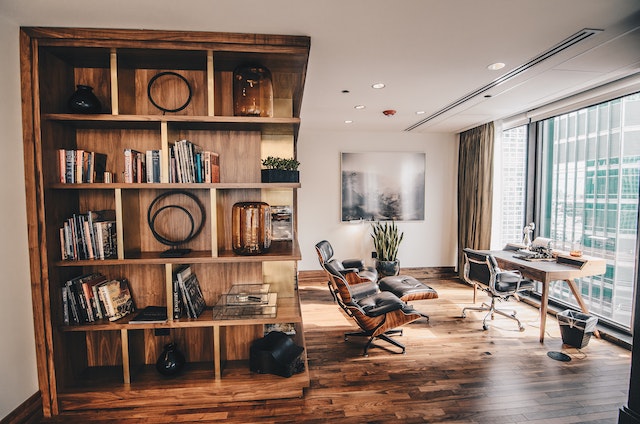
Curtain Track Systems: If you prefer a more fluid and versatile solution, curtain track systems offer endless possibilities. By installing a ceiling-mounted track, you can easily slide curtains back and forth to modify the layout of your space. You can create intimate nooks, open up larger areas, or even partition off a portion of the room for added privacy.
Practical tip: Use different types of curtains, such as sheer and blackout options, to adjust the level of light and privacy according to your needs.
Artistic Screens: For those who appreciate the beauty of art, artistic screens offer the perfect blend of functionality and aesthetic appeal. These dividers feature intricate designs, whimsical patterns, or stunning artwork that not only divide the room but also serve as eye-catching focal points.
Practical tip: Choose screens that complement the color scheme and theme of your interior for a truly harmonious aesthetic.
Maximizing Light and Airflow
In the pursuit of functional boundaries, it is essential to consider the impact on natural light and airflow within a space. While room dividers provide practical solutions for defining areas, they should not hinder the flow of light or restrict the circulation of fresh air. By carefully selecting room dividers and incorporating strategic design elements, you can maximize the light and airflow in your small interior.
Strategic Placement: One of the key factors in maximizing light and airflow is the strategic placement of your room dividers. Consider the natural sources of light in your space, such as windows or skylights, and position your dividers in a way that allows light to filter through. This can be achieved by opting for dividers with translucent materials, such as frosted glass or fabric panels, that still create a sense of separation while maintaining a connection with the surrounding areas.
Open Patterns: When choosing room dividers, opt for designs with open patterns or slatted features. These allow light to penetrate through the dividers, casting beautiful patterns and creating a sense of openness. Dividers with intricate laser-cut designs or geometric patterns can add visual interest while maintaining a spacious feel.
Reflective Surfaces: Incorporating reflective surfaces in your room dividers can help bounce natural light around the space, further enhancing the brightness. Consider dividers with mirrored panels or metallic finishes that can amplify the available light and create the illusion of a larger area.
Translucent Materials: To maintain privacy while still allowing light to flood the room, consider room dividers made from translucent materials. These dividers diffuse the light, creating a soft and ethereal ambiance. Materials such as rice paper, sheer fabric, or acrylic sheets can be used to achieve this effect, adding a touch of elegance and tranquility to your space.
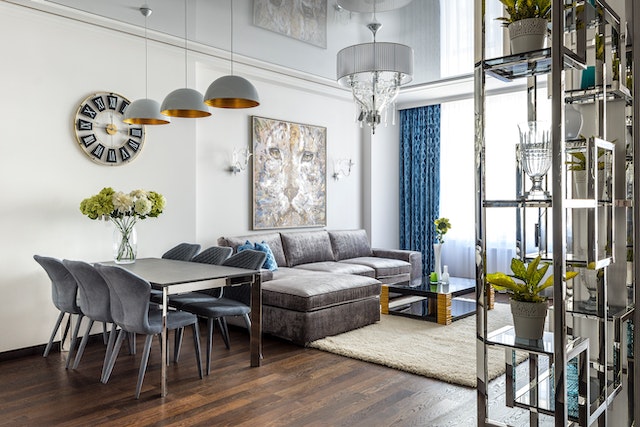
Hang Sheer Curtains: Another way to maximize light and airflow is by hanging sheer curtains in combination with your room dividers. Sheer curtains not only filter light but also allow air to move freely, ensuring proper circulation throughout the space. By choosing curtains in light, breezy fabrics such as linen or voile, you can maintain a sense of openness while still establishing distinct areas.
Utilize Natural Ventilation: In small interiors, optimizing airflow is essential to create a comfortable and inviting environment. Consider incorporating room dividers that allow for natural ventilation, such as those with open shelves or perforated panels. These dividers not only promote airflow but also serve as functional storage solutions, keeping your space organized and clutter-free.
Plants as Room Dividers: Greenery not only adds aesthetic appeal to a space but also contributes to air purification and humidity control. Consider using large potted plants strategically placed as room dividers. Not only will these dividers create visual separation, but they will also enhance the natural airflow and introduce a vibrant touch to your interior.
Practical Tip: To further enhance the brightness, choose light and neutral colors for your room dividers. Light-toned dividers reflect more light, making the space feel airy and expansive.
DIY and Customization Options
Part of the appeal of room dividers lies in their ability to be customized and transformed to suit our individual tastes and needs. With a little creativity and some DIY know-how, you can take your room dividers to the next level and make them truly unique. Here are a few ideas to inspire you:
Paint and Stencil: One of the simplest ways to personalize your room dividers is by adding a fresh coat of paint or incorporating stenciled designs. Choose a color that complements your interior and consider using stencils to create patterns or motifs that reflect your style. Whether it’s a bold geometric print or a delicate floral pattern, this DIY option allows you to infuse your dividers with a touch of artistry.
Practical tip: Use painter’s tape to create clean, crisp lines when applying paint or stencils.
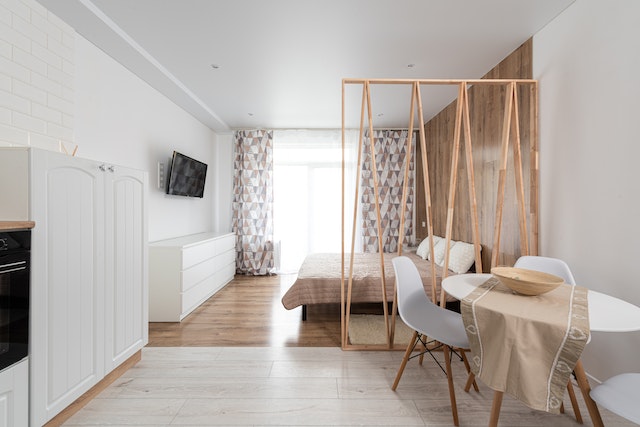
Decoupage: For a whimsical and eclectic look, try your hand at decoupage. Gather images, patterns, or even pages from your favorite books and magazines and adhere them to your room dividers using a decoupage medium. This technique allows you to tell a story or create a collage that reflects your interests and passions.
Practical tip: Make sure to seal your decoupage with a protective finish to ensure durability and longevity.
Fabric Wrapping: If you prefer a softer and more textured look, consider wrapping your room dividers with fabric. Choose a fabric that complements your interior’s color palette and style, and use adhesive or staple gun to attach it to your dividers. This DIY option not only adds visual interest but also introduces an element of warmth and coziness to your space.
Practical tip: Opt for fabrics that are easy to clean and maintain, especially if you have pets or children.
Hanging Art and Photos: Transform your room dividers into gallery walls by hanging framed artwork or photographs. Mix and match pieces of different sizes and styles to create a visually engaging display. This personalized touch adds character to your room dividers while allowing you to showcase cherished memories and artistic pursuits.
Practical tip: Use removable adhesive hooks or picture hanging strips to ensure easy installation and prevent damage to your dividers.
DIY Shelves and Storage: If you’re looking to maximize functionality, consider adding DIY shelves or storage compartments to your room dividers. This customization option allows you to create additional storage space for books, plants, or decor items. By incorporating shelves into your dividers, you not only define different areas but also provide practical solutions for organization and display.
Practical tip: Measure your space and plan out the dimensions of your shelves beforehand to ensure a seamless integration with your room dividers.
Additional Tips for Room Dividers for Small Interiors
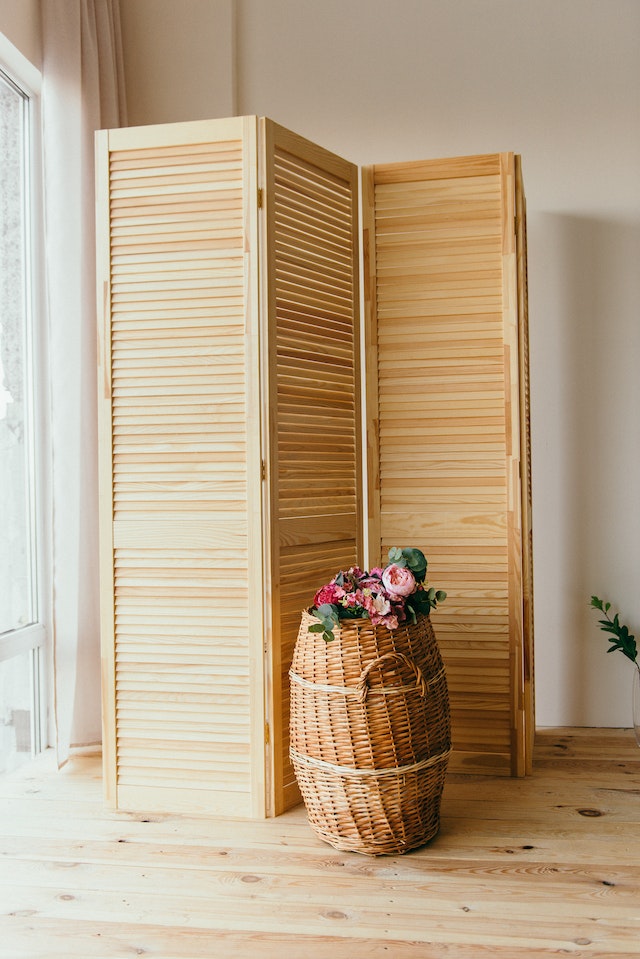
- Consider the Scale: When choosing a room divider, consider the scale and proportions of your space. A small, delicate divider may get lost in a large room, while an oversized divider could overwhelm a small area. Choose a size that complements the dimensions of your space and maintains a sense of balance.
- Take Inspiration from the Surroundings: Look to the existing elements in your interior for inspiration when selecting a room divider. Consider the colors, textures, and materials already present in the room and choose a divider that harmonizes with the overall aesthetic. This will create a cohesive and visually pleasing environment.
- Think about Functionality: Before selecting a room divider, consider the specific functions you want to achieve. Are you looking to create privacy, define separate zones, or simply add a decorative element? Understanding your goals will help you choose the right type of divider and ensure it serves its purpose effectively.
- Experiment with Placement: Room dividers do not have to be placed in a conventional straight line. Feel free to experiment with different angles and orientations to create a more dynamic and unique space. Angling a divider can help create visual interest and break up the monotony of a linear layout.
- Consider Light Transmittance: If maintaining natural light is important to you, opt for dividers that allow light to filter through. Translucent materials like glass, acrylic, or sheer fabric can maintain a sense of brightness while still providing separation. If privacy is a greater concern, choose dividers with more opaque materials.
- Coordinate with Room Flow: Consider the flow of movement in your space when placing room dividers for small interiors. Ensure that the divider does not obstruct the natural movement from one area to another. By positioning dividers strategically, you can create a clear path while still achieving a sense of separation.
- Use Dividers as Decorative Accents: Room dividers for small interiors can also serve as decorative accents in your space. Choose dividers with interesting patterns, textures, or colors that complement your interior design. Treat them as functional art pieces that enhance the overall aesthetic of your room.
- Experiment with Texture: Incorporating texture into your room dividers can add depth and visual interest to a space. Consider dividers with materials like woven rattan, textured metal, or fabric panels with unique patterns. This can create a tactile element that adds personality and richness to your interior.
- Don’t Forget about Maintenance: Keep in mind that different types of room dividers require different maintenance routines. Some dividers may need regular dusting or cleaning, while others may require occasional polishing or re-staining. Choose dividers that align with your lifestyle and maintenance preferences.
Room dividers for small interiors have the power to transform limited spaces , creating functional boundaries while maintaining a sense of openness and style. Whether you choose a folding screen, bookcase divider, sliding panel, or any other type, the key is to select a divider that complements your space and fulfills your specific needs. By considering factors such as scale, functionality, placement, and aesthetics, you can achieve a well-defined, organized, and visually stunning interior.
